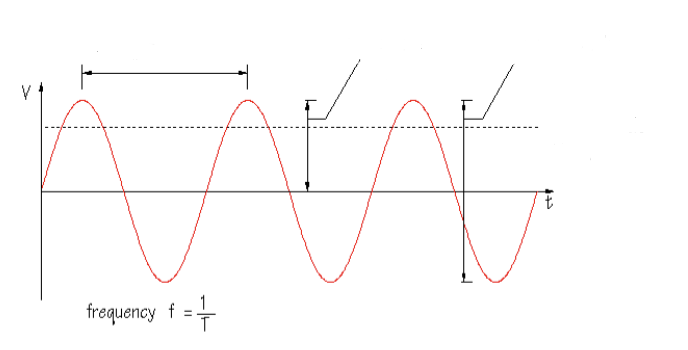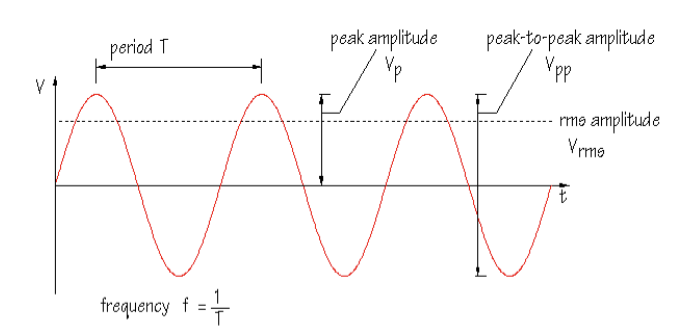Hearing Science Final
1/80
There's no tags or description
Looks like no tags are added yet.
Name | Mastery | Learn | Test | Matching | Spaced |
|---|
No study sessions yet.
81 Terms
Define sound
Fluctuations in air pressure across time
Define hearing
Process that transforms sound waves into neural signals that can be interpreted by our brain
Define hearing science
The relationship between the physical properties of sound and the sensation they produce
Identify parts of a sounds waveform
Sounds is a longitudinal compression wave represented as a sine wave
Peaks are pressure condensations
Zero is resting pressure
Troughs are pressure refraction as troughs

Identify the parts of this graph (peaks, etc.)

Calculate the frequency of a sine wave given it's frequency
F = 1/T
Understand the relationship between the waveform and magnitude spectrum of a sine wave
Frequencies are lines across the x-axis with height of amplitude on the y-axis
Identical magnitude spectra for sine waves with the same amplitude and frequency
One line is a single-frequency tone
Multiple lines is a complex tone
Identify the essential parameters needs to represent a sinusoid of a sine wave
Frequency, Amplitude, Phase
Identify the essential parameters needed to represent the magnitude spectrum of a sine wave
Frequency, Amplitude, and NOT Phase
Distinguish between sounds with a continuous spectrum (e.g., white noise) and those with a discrete spectrum (e.g., sine waves, complex tones)
Continuous spectrum (e.g., white noise): Contains energy at all frequencies within a certain range
Discrete spectrum (e.g., sine waves, complex tones): Contains energy at specific, isolated frequencies
Understand the major differences between a complex tone and a pure tone
Pure tone has one frequency component
Complex tone has more than one frequency component (typically harmonic)
Understand the relationship between complex tone’s period and the period of its fundamental component
They are identical
Describe the spacing between harmonics in complex tones
Constant
Contrast the differences between low-pass, high-pass, and band-pass filters
Low-pass filter removes high frequencies
High-pass frequencies removes low frequencies
Band-pass filter removes frequencies outside of its band width
Bandwidth is ____ from peak (50% relative power)
-3dB
Explain why dB is useful in hearing science
Compressive: The human ear is sensitive to 1013 units of intensity on a linear scale; a logarithmic scale condenses that range to 130 decibels
Closer to human sensation: The logarithmic scale more closely approximated the way human ears perceive loudness, Each increase in decibel corresponds roughly to an equal perceived growth in loudness, even though the sound power differences are large
10-fold increase in pressure =
+20dB
100-fold increase in pressure =
+40dB
1000-fold increase in pressure =
+60dB
Double the pressure =
+6dB
Quadruple the pressure =
+12dB
Understand the Steven’s Power Law
Describes the sensory growth as compressive with increasing stimulus intensity
Identify the physical properties of a sound that affect its loudness
intensity
Frequency: Equal loudness contours equal loudness contours
Duration: “Critical duration”
Identify the physical properties of a sound that DO NOT affect its loudness
Phase
Use equal loudness contours to compare the loudness of pure tones at different frequencies and SPLs
Find the intersection of frequency (x-axis) and SPL (y-axis) then report the hearing threshold of the curve
Equal loudness contours
Flatter at higher loudness levels — less of a difference in perceives loudness as a function of frequency
Rate of growth of loudness differs for tones of different frequencies
Describe the roles of the outer ear in audition
Pinna: Significantly modifies the incoming sound, at high frequencies, which is important for sound localization
Ear Canal: Resonance frequency around 3kHz
Describe the role of the middle ear in audition
The lever action of the ossicular chain amplifies incoming sounds
Understand properties of the basilar membrane (hint: tonotopically organized)
Located in the inner ear
The place of maximum displacement depends on stimulus frequency
High frequencies excite the base while low frequencies excite the axis
Nonlinear response
Differentiate between types of hair cells
Understand Fletcher’s critical-band experiment, identifying the independent variable and the dependent variable
Purpose: Measure bandwidth of auditory filters
Independent Variable: Making noise bandwidth
Dependent Variable: Signal amplitude
Control: Signal frequency, Noise amplitude at threshold
Determine the critical bandwidth of an auditory filter centered at a specific frequency from experimental results
Critical bandwidth graph
“Knee point”
400 Hz
Identify the dependent variable and independent variable in the tone-on-tone masking experiment
Purpose: Measure the shape of the auditory filter across frequencies (effectively basilar membrane)
Independent Variable: Masker frequency
Dependent Variable: Masker amplitude at threshold
Control Variables: Signal amplitude at threshold, Signal frequency
Predict which single-frequency pure tone will mask a target tone at the lowest level
Best masking → Worst masking
Same frequency, Closest frequency, Lowest frequency
Identify factors influencing the narrowness of auditory filters
Frequency
SPL: More = wider
Hearing loss
Compare the effectiveness of different types of masking
Best Masking → Worst Masking:
Forward fringe
Backward fringe
Forward
Backward
Understand central masking including how dichotic listening conditions differ between backward and forward masking
Central masking can occur during dichotic listening conditions due to a central mechanism
Backward masking is an example that can occur centrally
Understand how sound integration changes until the critical duration
For durations up to the critical duration, sounds with longer duration are detected more easily
Identify the parameters of amplitude modulation
Modulation depth or amplitude modulation (AM)
Modulation rate or frequency modulation (FM)
Understand temporal modulation transfer functions (TMTFs)
The plot of AM detection thresholds as a function of modulation rate
Threshold is plotted as modulation depth in dB with low (good) values at the bottom
What does a TMTF “cut-off” AM implicate?
The auditory system acts like a low-pass filter when it comes to temporal fluctuations in sounds, with a cutoff frequency (3dB down point ) around 50-60 Hz
We can follow fluctuations up that modulation rate fine, but at higher rates, we don’t follow as well
Identify the independent and dependent variable in experiments measuring TMTFs
Independent variable: Modulation frequency
Dependent variable: Modulation depth at the threshold
Control variables: Carrier amplitude at the threshold, Carrier frequencies at the thresholds
Explain which frequency range the temporal theory can explain pure-tone pitch perception
Low frequencies under 1000 Hz
Use phase-locking mechanism
Explain which frequency range the place theory can explain pure-tone pitch perception
Works for low and high frequencies
Best for high frequencies above 2000 Hz
Calculate the frequency of beats generated by two sine waves
Difference in Hz
Beats (500,450) = 50
Describe how neurons phase-lock to the fine structure for resolves harmonics and to the temporal envelope (beating frequency) for unresolved harmonics
Two mechanisms for complex-tone pitch perception
Pattern matching of resolved harmonics works for low-frequency harmonics
Temporal envelope coding of unwanted harmonics: works for high-frequency harmonics
Understand with which type of harmonics the temporal code is dominant for the perception of complex-tone pitches
Unresolved harmonics
Identify the three main aspects of spatial perception
Azimuth angle
Elevation angle
Distance
Identify the aspect of spatial perception to which humans are more sensitive
Azimuth angle
Identify the major cues for azimuth angle perception
Intramural time difference (ITD)
Intramural level difference (ILD)
Identify the major cues for duplex theory
ITD - low
ILD - high
Explain at which frequency ILD is biggest and the primary reason for ILD
Head, above 2000 Hz
Head shadow effect
Explain for which frequency range ITD is most effective for sound localization and the primary reason for ITD
Low, under 1000 Hz (exists for high, but not effective)
Phases differences from path length
Identify what auditory cues are important for distance perception
Intensity cues (attenuation over distance): Gets quieter with more distance
Reverberation cues: Important for distance
Explain how human sound localization resolves front-back confusion
Identify examples of organizing principles
Onset timing: Sounds starting at different times likely from different sources
Ex. Forward fringe masking
Location: Single sound source comes from one location
Ex. Bilateral masking level difference (BMLDs)
Coherent temporal changes: Matched AM and/or FM changes over time
Ex. Comodulation Masking Release (CMR)
Gestalt principles in audition: Similarity
Similar pitches heard as one stream; different pitches as separate stream
Gestalt principles in audition: Proximity
Sounds close in time or frequency tend to group together
Gestalt principles in audition: Continuity
Sounds perceives as continuing behind interrupting noise
Gestalt principles in audition: Common fate
Sounds changing together (in amplitude, frequency) grouped together
Identify the primary determinant of a speaker’s pitch
Acoustic source, i.e., glottal pulses from vocal fold vibrations
Identify the major acoustic properties determining English vowels
Formant frequencies (primarily the first 2)
Identify the main attributes for English consonant classification
Place, Manner, Voice
Understand aspects of the Motor Theory of speech perception
Speech perception involves reference to articulation
Specialized neural module translates acoustic signals to articulatory gestures
Analysis-by-synthesis mechanism
Evidence: Categorical perception, McGurk effect, duplex perception
Unilateral vs. Bilateral
One vs. both
Congenital vs. Adventitious
Congenital: At birth
Adventitious: Acquired after birth
Hearing loss based on time course
Acute vs. Chronic
Temporary vs. Permanent
Progressive vs. Fluctuating
Conductive hearing loss
Problem in outer/middle ear
Constant threshold elevation across frequencies
Air-bone gap present on audiogram
Sensorineural hearing loss
Problem in cochlea or auditory nerve
Often worse at high frequencies
No air-bone gap
Mixed hearing loss
Both conductive and sensorineural components
Air-bone gap, but less than conductive hearing loss
Identify the major signal-processing strategy used in modern hearing aids
Amplification: Making sounds louder
Filtering: Emphasizing certain frequencies
Compression: Reducing dynamic range
High gain for low intensities
Low gain for high frequencies
Addresses recruitment problem
Linear signal processing
Constant gain regardless of input level
Non-linear signal processing
Gain changes with input level
Automatic Gain Control (AGC)
Multi-channel processing for different frequency regions
Identify the problem with linear signal processing in hearing aids and the solution
Problem: Loud sounds become uncomfortable
Solution: Peak clipping, but this causes distortion
Understand the function of cochlear implants
Bypass damaged hair cells to stimulate the auditory nerve directly with electrical signals
Identify the signal-processing component unique to cochlear implants
Use vocoding
Explain the difference in candidacy between hearing aids and cochlear implants
HA: Moderate sensorineural hearing loss, unilateral or bilateral
CI: Bilateral severe-profound sensorineural hearing loss, limited benefit from hearing aids, no medical contradictions
Cochlear implants in adults and children
Adults: Poor speech recognition, telephone use different
Children: 12+ months, lack of benefit from hearing aids
Explain the main differences between a prescription hearing aid and OTC hearing aid
Prescription HA: require a hearing test, tailored to your needs
OTC HA: Not fit by an audiologist, for mild-moderate hearing loss
Describe the challenges of using untrained interpreters in audiology settings
Misinterpretations, inaccuracy in communication
Understand that speech in background noise involves multiple neuro-cognitive processes and neurofeedback training of selective attention may provide an effective rehabilitation strategy
-